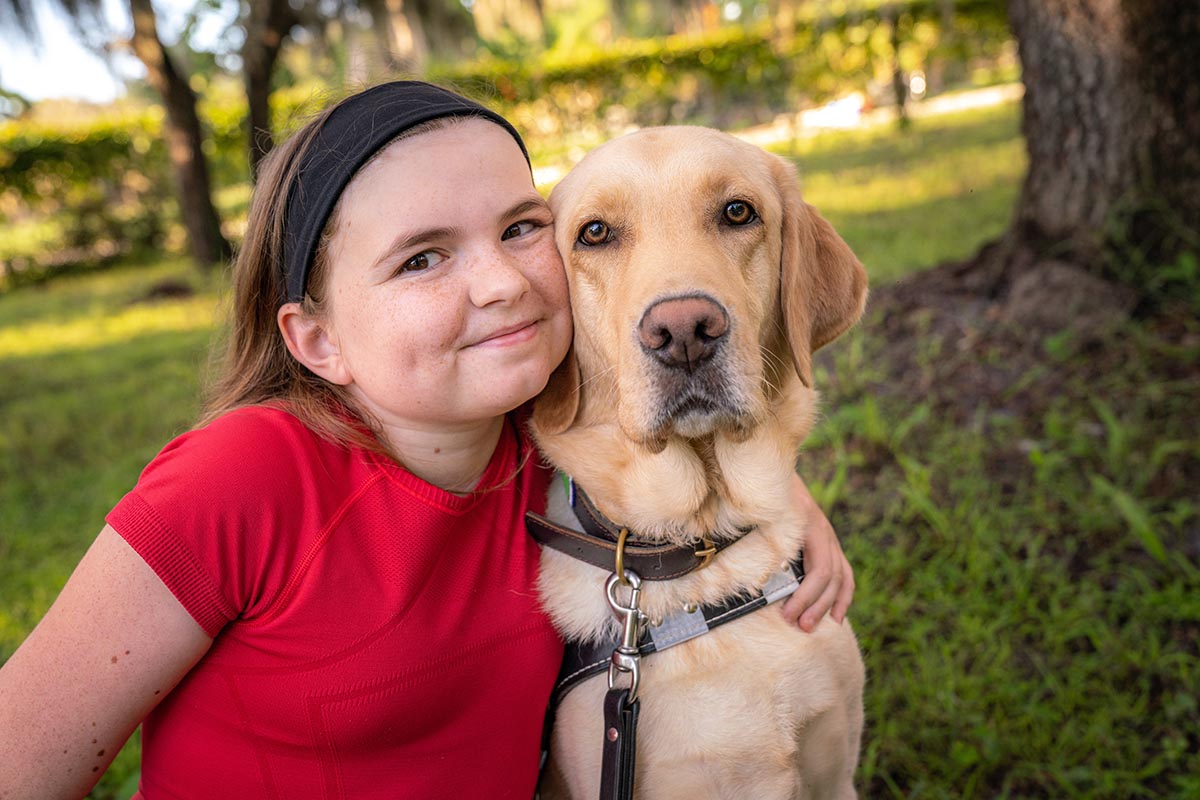
SOUTHEASTERN GUIDE DOGS PHOTOS
A legally blind teenager named Valerie hugs her new best friend, Mickey, a guide dog placed with her by Southeastern Guide Dogs at no charge through its Youth Guide Dogs program. Through various partnerships, SEGD also provides free Fromm’s dog food, Elanco flea and tick preventatives, plus annual veterinary wellness visits and vaccinations.
Southeastern Guide Dogs programs provide dogs for legally blind children, teens
By LOIS KINDLE
Southeastern Guide Dogs is widely known for breeding, raising and providing exceptional guide dogs to legally blind adults and equally as extraordinary service dogs to veterans with PTSD. But it has also introduced three lesser-known programs in recent years aimed at helping young kids and teens.
These include Guide Dog Camp for teens 14 to 17 who are legally blind or have a medical condition leading to legal blindness; Youth Guide Dogs for teens 15 to 17 who are legally blind; and Kids Companion Dogs for children of any age who have a diagnosis of legal blindness or condition leading to it.

During Guide Dog Camp, a teenager named Anabell learns what it’s like to walk an expertly trained guide dog with Southeastern Guide Dog instructor Karin. Guide Dog Camp is for teens 14 to 17 who are legally blind or have a medical condition leading to legal blindness.
Guide Dog Camp is an overnight two-day, immersive experience, giving teenagers and their parents a variety of opportunities to work with highly trained guide dogs, said Katie Perez, manager of programs for children and teens and certified guide dog instructor. Campers learn the ropes about working with a dog in harness, handling a guide dog, taking care of it and more. The program is free and includes dorm lodging on the SEGD campus in Palmetto, chef-prepared meals and pizza night.
“This is the first time most or all of our camp’s participants have a chance to do this,” she said. “We purposefully keep the camp small, topping it out at six campers and their parents.”
There have been a total of six camps since the first one in March 2019, and 26 campers have participated thus far. To officially apply for a guide dog under the program’s requirements, a teen has to be at least 15 years old and have sufficient individual orientation and mobility skills, Perez said. In other words, the teen had to be able to navigate on his or her own independently and safely.
Of the 26 teens who went through camp, 19 met the qualifications and applied for a dog immediately. Six of those have received guide dog placements to date.
SEGD currently has a total of 16 teen applications for guide dogs pending. Some of those who applied did not attend camp.

A child named Millie sits on the porch with her companion dog, Miracles. Provided at no cost by Southeastern Guide Dogs, these special dogs provide love, emotional support and a sense of purpose to children who have a diagnosis of legal blindness or condition leading to it.
“It’s not required they go, but it’s highly recommended,” Perez said.
The Youth Guide Dogs program was started by Perez in March 2018, and its first placement was in March the following year.
This program is similar to the school’s adult guide dog program, except that teens come to stay on campus with others their own age to be matched and work with their fully trained guide dogs for seven to 10 days, instead of the three weeks required of adults.
Certified SEGD instructors follow the teens home to complete their formal training with the dogs within their communities and at school, typically for another 10 days. The graduates gain new independence through learning dog handling, obedience and navigation skills.
Valued at $50,000 from birth to retirement (usually around age 11), the guide dog is provided at no cost. Through various partnerships, SEGD also provides free Fromm’s dog food, Elanco flea and tick preventatives, plus annual veterinary wellness visits and vaccinations.
The SEGD Alumni Support team follows up with assistance for life, Perez said.
The Kids Companion Dogs program’s purpose is to “prepare children too young to have a guide dog right now for one in the future,” Perez said.
The dogs involved with these kids have been “career transferred” in Guide Dog University for minor medical, environmental or behavioral issues.
“It can be for something as simple as the dog is nervous about being in large amounts of traffic or walking over a metal grate or broken sidewalk,” Perez said. “Some of these dogs have 60 to 70 hours of formal training. All are still wonderful dogs, who excel in obedience, house manners and a love for kids, which gives us the ability to place them with young children.”
Perez said participants in this program need to be able to have at least some responsibilities with the dog in order to establish bonding. They learn to walk, play, groom and feed their dog and gain a sense of ownership, responsibility and maturity, she said.
The program’s first placement was in Dec. 2018, and 25 children have received companions to date.
Perez said most of the children involved in the Kids Companion Dogs program have vision loss due to another medical condition, such as brain cancer, albinism or a genetic disorder. Their dogs, which are provided at no cost, provide love, emotional support and a sense of purpose.
To learn more or apply for any of these SEGD programs for children or teens, visit www.guidedogs.org/camps/.

